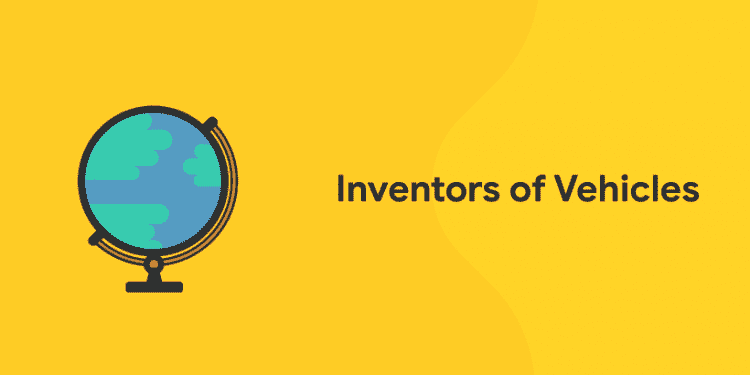Table of Contents
Travelling has become the passion of the world in the last 10 years. The number of travelers across the world has increased many folds. Traveling has become easier and faster compared to the 18th century to the 21st century. Transportation of people and cargo has been done with ease since the invention of vehicles. Vehicles moved with animal power evolved to technologically driven vehicles, super-fast trains, bullet trains, supersonic air crafts. Let us check the names of the inventors of vehicles and the year of their invention.
Inventors of Vehicles
| Year of Invention | Vehicle Invented or related inventions | Inventor |
| 1769 | Motorcar (first self-propelled vehicle with a steam engine) | Nicholas Cugnot |
| 1775 | Ship (steam) | JC Perier |
| 1776 | Submarine | David Bushnell |
| 1804 | Steam locomotives | Richard Trevithick |
| 1825 | Railway (passenger steam) | George Stephenson |
| 1834 | Streetcar | Thomas Davenport |
| 1839-40 | Bicycle | Kirkpatrick Macmillan |
| 1852 | Airship | Henri Giffard |
| 1860 | Engine (internal combustion) | Jean-Joseph Etienne Lenoir |
| 1863 | Subway | Charles Pearson |
| 1864 | Automobile (internal-combustion and gasoline-powered) | Siegfried Marcus, Karl Benz |
| 1870 | Penny-farthing bicycle | James Starley |
| 1876 | Carburetor | Gottlieb Daimler |
| 1885 | Motorcycle | G Daimler of Cannstatt |
| 1888 | Bicycle tyres | John Boyd Dunlop |
| 1888 | Petrol Car | Karl Benz |
| 1888 | Tyre (pneumatic, with valve) | John Dunlop |
| 1892 | Diesel engine | Rudolf Diesel |
| 1894 | Ship (turbine) | Sir C. Parsons |
| 1895 | Diesel Engine | Rudolf Diesel |
| 1903 | Airplane (controlled and engine-powered flight) | Orville and Wilbur Wright |
| 1903 | Rocket (liquid-fueled) | Konstantin Tsolkovsky
Robert Goddard |
| 1907 | Helicopter | Louis and Jacques Breguet |
| 1910 | Seaplane | Henri Fabre |
| 1932 | Parking meter | Carlton C. Magee |
| 1943 | Aqualung | Jacques Cousteau |
| 1955 | Hovercraft | Christopher Sydney Cockerell |
| 1961 | Airbag | Arnold Kent |
| 1961 | Spaceflight (manned) | Yuri Gagarin (not the inventor of spaceflight) |
Practice the mock tests for the Banking Exams General Awareness 2021 Mains Exam.
Major Modes of Transportation and Types of Vehicles
Five various modes of transportation
- Road transport
- Railway transport
- Water transport
- Air transport
- Pipeline transport
Types of Vehicles
- Amphibious vehicles (screw-propelled vehicle, hovercraft)
- Aircraft (airplanes, helicopters)
- Bicycles
- Motor vehicles (such as motorcycles, cars, trucks, buses)
- Railed vehicles (trains, trams)
- Watercraft (ships, boats)
- Wagons
- Spacecrafts
Rank Booster Quizzes on Current Affairs for all Government Competitive Exams
| Related Courses | ||
| RRB Exams Coaching | RRB JE Online Coaching | SSC JE Online Coaching |
| SSC Online Coaching | UPSC Online Coaching | Bank Exam Coaching Online |
History of Vehicles
- Log boats – were the oldest boats found by archaeological excavation. The oldest one was found, the Pesse canoe found in a bog in the Netherlands, being carbon dated to 8040 – 7510 BC.
- Then, a 7,000-year-old seagoing boat made from reeds and tar has been found in Kuwait.
- 4000 -3000 BC – Boats were used in Sumer, ancient Egypt, and in the Indian Ocean.
- 4000–3000 BC – Camel pulled wheeled vehicles were known
- Around 600 BC – Evidence for the predecessor of the railway, a wagonway, found so far was the 6 to 8.5 km (4 to 5 mi) long Diolkos wagonway. This was to transport boats across the Isthmus of Corinth in Greece.
- In 200 CE, Ma Jun built a south-pointing chariot
Railways began reappearing in Europe after the Dark Ages. The earliest known record of a railway in Europe from this period is a stained-glass window in the Minster of Freiburg in Breisgau dating from around 1350
- 1769 – Nicolas-Joseph Cugnot is credited with building the first self-propelled mechanical vehicle or automobile
- 1780 – Ivan Kulibin developed a human-pedaled, three-wheeled carriage with modern features such as a flywheel, brake, gearbox, and bearings in Russia.
- 1783 – Montgolfier brothers first developed balloon vehicle
- 1801 – the first demonstration of a steam-powered road vehicle by Richard Trevithick built and demonstrated his Puffing Devil road locomotive
- 1817 – Pushbikes, draisines, or hobby horses were the first human means of transport to make use of the two-wheeler principle.
German Baron Karl von Drais is regarded as the forerunner of the modern bicycle (and motorcycle). It was introduced by Drais to the public in Mannheim in the summer of 1817.
- 1885 – The first automobile was built by Karl Benz. It was powered by his own four-stroke cycle gasoline engine in Mannheim, Germany
- 1885 – Otto Lilienthal began experimental gliding and achieved the first sustained, controlled, reproducible flights.
- 1903 – Wright brothers flew the first controlled, powered aircraft
- 1907 – The first helicopters Gyroplane no.1 and Cornu helicopter
- 1928 – Invention of Opel RAK.1 rocket car
- 1929 – Invention of Opel RAK.1 rocket glider
- 1961 – Vostok vehicle carried the first human into space (Yuri Gagarin)
- 1969 – Apollo Program first manned vehicle landed on the moon
- 2010 – It is found that the number of road engine vehicles in operation worldwide exceeded 1 billion.
Get more static GK and general awareness notes
Abbreviation related to Automobiles
- A4 – 4-speed automatic transmission
- A5: 5-speed automatic transmission
- A6: 6-speed automatic transmission
- ABS – Anti-lock braking system
- AC – Alternating Current
- A/C – Air conditioning
- CNG – Compressed natural gas
- CO2 – Carbon dioxide
- CVVL – Continuous variable valve lift
- CVT – Continuously variable transmission
- DC – Direct current
- EPB – Electronic Parking Brake
- EPS – Electric power steering
- ESP – Electronic stability program
- EWP – Electric water pump
- EWP – Elevating work platform
- FDC – Fixed displacement compressor
- FWD – Front-wheel drive
- GVW – Gross vehicle weight
- GVWR – Gross vehicle weight rating
- GWP – Global warming potential
- HAD – Highly Autonomous Driving
- HC – Hydrocarbons
- HEV – Hybrid-electric vehicle
- HFC – Hydrofluorocarbon
- hp – Horsepower
- LED – Light Emitting Diode
- LEV: Low-emission vehicle
- LPG – Liquified petroleum gas
- SULEV – Super ultra-low emission vehicle
- SUV – Sport utility vehicle
- Turbo – Turbocharging
- ULEV – Ultra-low emission vehicle
- V6 – Vee-formation six-cylinder
- 4WD – Four-wheel-drive
Other Article Links Related to Transport Systems:
List of National Highways in India
List of National Highways Passing through Kerala
List of Transport Systems in India for Competitive Exams
National Road Safety Week 2021 – Facts, Quiz
So, these all regarding the development of vehicles to the modern era. The automobiles change to the electronic period, which is now supported to cope up with the pollution. The emergence of hydrogen and more durable material for automobile bodybuilding is also monitored by the world. Vehicle lovers are always looking to the new technological innovations in this industry. Get inspired with a vehicle-related quote by Israelmore Ayivor, “Your vehicle of leadership is fueled by your willingness to learn. You can’t lead if you can’t learn!”














